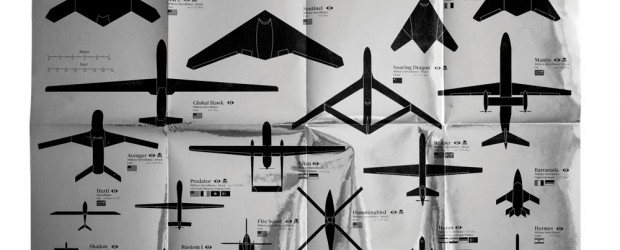DRONE SURVIVAL GUIDE, 2012-ongoing
DRONE SURVIVAL GUIDE, 2012-ongoing
I imagine twenty people, gathered around a large table, looking upwards, even if there are no feathers floating there; they are all the more confused and nervous because the thing that scares them is neither opposite (like an enemy you could kill) or beneath (like a trap which the secret police could foil), but somewhere above them, like an invisible threat, insubstantial, inexplicable, uncatchable, unpunishable, and mischievously mysterious.
Milan Kundera, La Fête de l’insignifiance, Ed. Gallimard, Paris, 2014, p.93 In Cataloog Villa Empain expo
Our ancestors could spot natural predators from afar by their silhouettes. Are we equally aware of the predators of present-day? The Federal Aviation Administration (FAA) predicted in 2012 that within 20 years there could be as many as 30.000 drones flying over U.S. soil alone. As robotic birds will become commonplace in the near future we should be prepared to identify them. This survival guide is an attempt to familiarise ourselves and future generations with a changing technological environment. This document contains the silhouettes of the most common drone species used today and in the near future. Each indicating nationality and whether they are used for surveillance only or for deadly force. All drones are drawn in scale for size indication. From the smallest consumer drones measuring less than a metre, up to the Global Hawk with a length of 39.9 metres. The guide itself is printed on paper with a reflective metallic coating, so it can be used to reflect sunlight into the drone's camera system. The mirrored material also reminds us that drone surveillance is ultimately people watching people. In a way we are looking at ourselves through sophisticated mirrors.
The Drone Survival Guide is collected and translated as a form of civil initiative, not for profit and without government or commercial funding and/or support, for the sole purpose of making information available to the public. On the website the guide can be downloaded and used for free. Readers of the site have supplied translations of the guide into 30 languages, all free to download: www.dronesurvivalguide.org
Ruben Pater (NL)
°1977, Gouda
Under the name Untold Stories, Dutch graphic designer Ruben Pater creates visual narratives about geopolitical issues. He initiates projects in which research is followed by visual ways of storytelling for a wide audience, creating new relations between journalism and design. Ruben Pater finished the master programme of design at the Sandberg Institute in Amsterdam, and teaches at the Royal Academy of Art in the Hague.


